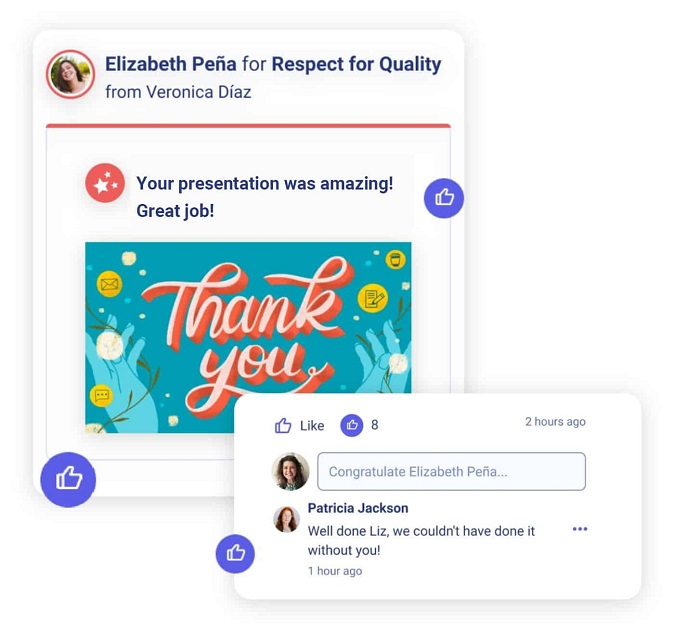How to Measure Employee Engagement

Learning how to measure employee engagement can be a challenging feat. You're trying to gauge numbers based on the connection employees feel toward the company which is largely internal and intangible.
Engaged employees invest more of their effort and time into the company, giving you high-performers. An increase in engagement also reflects on your business’ consumer satisfaction.
According to a Glassdoor studyOpens in a new tab, a one-point increase in employee experience rating relates to a 1.3-point increase in consumer satisfaction.
These rates may indicate if an employee is highly unlikely to recommend working at the company or it could hint at the absenteeism rate both of which will contribute to your employee engagement score.
Over 85%Opens in a new tab of business owners believe in the power and impact of high employee engagement. Calculating an organization's employee engagement can serve a crucial role in raising productivity levels and decreasing turnover rates.
Let's discuss everything you need to know about measuring employee engagement.
Benefits of measuring employee engagement
According to Gallup,Opens in a new tab among the 100 million U.S. full-time workforce, just one-third of them are actively engaged. Meanwhile, 18% of employees are considered actively disengaged.
The disengaged portion tends to cost a whopping $483 to $605 billion annually. These numbers can come from evading potential consumers or negative influence in the workplace.
For this reason, employee engagement is a critical force, and measuring it is one of the first steps in increasing it. Additionally, quantifying engagement levels will improve employee loyalty to the company and reinforce the company values.
Not only do measuring tools help staff, but they also benefit management. Pulse surveys and other kinds of methods of gauging engagement provide feedback to management. In turn, they can work on ways to increase employee retention and avoid a high turnover rate.
KPIs to measure employee engagement
Key performance indicators (KPIs) provide a holistic view of company performance across all departments and business initiatives. The same goes for measuring employee engagement. Here's what you should be measuring and tracking to understand employee engagement at your organization:
Turnover and retention rates
Maybe you've noticed a particular department with exceptionally high employee turnover rates. That's a telltale sign of a lack of employee engagement. One of the best ways to handle the high rates of employee turnover is to focus on exit interviews. Valuing employee feedback will get you to the bottom of issues causing employees to leave.
Plus, you can use the notes from the interview to create more specialized questions during hiring interviews to optimize your recruitment search. Likewise, you can conduct stay interviews to gain a step ahead on retention by asking employees reasons why they may leave the company or what you can do to keep them engaged and at the company.

Employee net promoter score
Asking employees "How likely are you to recommend working for us?" can reveal details about the employee experience. Statistical specialists identify this KPI as the Net Promoter Score (NPS).
The formula for evaluating the NPS involves subtracting the promoters from the detractors and dividing the result by the total number of employee respondents. That said, you can differentiate the promoters and detractors by phrasing the questions as, on a scale of one to ten, "How likely will you recommend working at our company to your friends?"
Employee absenteeism
An engaged employee is an attentive one. They're also an employee that shows up. According to GallupOpens in a new tab, between a low- and high-engagement workspace, there's a significant 81% difference in absenteeism rate.
Disengaged employees can cause a domino effect in the workspace if not properly handled. Their colleagues need to compensate for their share of the work, causing a more intense workload, and a decrease in overall employee satisfaction and experience.
Promotion rate
Another successful method to know how to measure employee engagement involves keeping track of internal promotions. Professional growth is one of the many drivers of engagement.
It allows you to take note of the company's ability to retain high-performing team members. You can measure this KPI by dividing the number of promoted employees by the number of employees. But this should also be sussed out in conversations with employees about what their career plans are and what paths for growth are available within the organization.
3 aspects of measuring employee engagement
Employee engagement constitutes three dimensions: emotional, cognitive, and physical. American psychologist and social scientist, Robert Kahn, developed these aspectsOpens in a new tab to discuss their levels and significance to employee experience.
Physical
The higher the physical expenditure an employee commits to a workplace, the more likely they're engaged. Whether it's walking around or running errands, taking action increases employee confidence and commitment to the company.
That said, physical engagement also improves your employee's feelings of productivity. You can boost this aspect through engagement strategies like walking meetings, encouraging time to focus on physical health, and offering ergonomic furniture.
Integrating a wellness program in your organization can reap mutual benefits for employers and employees. Research stipulates that a company’s medical expenditure decreases to about $3.27 for everyOpens in a new tab dollar spent on wellness programs.
Additionally, absenteeism costs also decline to approximately $2.73 for every dollar allocated to wellness programs. Aside from that, incorporating a well-being check-in on your employees can identify underlying problems leading to disengaged staff.
Emotional
The emotional aspect of measuring engagement focuses on how employees feel about their workplace. You may want to observe if individuals carry a sense of belonging in the work environment.
We suggest asking questions like, "Do the employees trust the company and their leadership to deliver their professional growth?"
Feelings of empowerment are also worth drawing upon when assessing engagement. Giving employees more flexibility and autonomy leads to a positive experience. Subsequently, these emotional aspects are reflected in the company's financial performance.
In addition, you can personalize the experiences and achievements of your staff through Life Events®. Celebrations can enhance company culture and lead to a 23% increase in your employee's mental health levels. It's further proof that the mental and emotional connection employees feel will yield a rewarding return rate.
Cognitive
Cognitive engagement Opens in a new tabprimarily focuses on the employee's concentration levels at work, whether it's during task completion or adhering to the company's vision. In this aspect, company knowledge is essential. Employees need to feel confident in their knowledge to apply it in their work seamlessly.

This is where employee recognition fits in. Awarding cognitively engaged employees can boost retention numbers. You can use tools similar to Workhuman's Social Recognition® to award high-achieving employees. You can also track to make sure that recognition is being given equitably across the organization.
You can use the contemporary method to honor their work milestones, like completing a significant project or winning a promotion.
Here are six more ways to increase employee engagement, regardless of the external challenges an organization may be facing.
What you will need to measure employee engagement
Measuring employee engagement requires multiple tools, such as surveys, email tracking tools, and KPI recording systems.
Pulse surveys
As their name suggests, HR specialists rely on these surveys to get a “pulse” on the employee’s engagement. It comprises a set of open-ended and scale questions that ask staff about their perceptions of work communication, environment, or leadership feedback.
Employee engagement surveys
Pulse and emotional engagement surveys are alike in aspects like outcomes. Nevertheless, they differ in terms of scope, frequency, and length.
The latter offers a more holistic view of the company. Plus, they’re much less frequent and take more time to complete. Pulse surveys are ideal during company changes or post-project operations.
NPS surveys
NPS surveys allow you to acknowledge your staff’s feelings towards the company. The survey is fast, easy to navigate, and effective at measuring employee engagement.
They’re also cost-effective and accurate. Its simplicity makes this tool a double-edged sword. While the survey is convenient, it doesn’t provide in-depth knowledge of why employees may or may not recommend you.
For this reason, you need to apply this survey with several other methods of measuring employee engagement.
Employee recognition tools

Well-appreciated employees are more likely to remain motivated and actively engaged in their workspace. Solutions like Workhuman’s Social Recognition® programs kickstart that culture of appreciation. The tool acts as a place for employers and peers to share their appreciation for one another. This tool will help you measure your engagement levels based on the platform’s activity levels. You can also observe the results through pulse surveys and check-in meetings.
Questions to measure employee engagement
Applying the right employee engagement questions will greatly benefit your qualitative and quantitative research. Here is a range of open-ended questions worth including in your pulse surveys or check-in meetings.
- How do our company values align with your work?
- What part of work do you look forward to the most?
- How does leadership play a part in your professional growth?
- Do you believe that you have enough autonomy from your manager?
- What is your prime motivation at work?
- How would you describe the recognition received from your last project?
- If there are three things you can change about your workflow, what would they be?
- Would you say this is a great place to work?
- How would you describe your work environment?
Step-by-step instructions
It's important to follow a step-by-step method when measuring employee engagement. They'll allow you to keep track of your progress, whether it's through survey results or any metric related to engagement.
Step 1: Set your goals

Before diving into your strategy of finding a way to measure employee engagement, you need to build a reference model of an engaged and disengaged team member.
For instance, a highly engaged employee will likely demonstrate initiative quality, professional growth, and attentiveness to company values.
In contrast, disengagement can show in the form of absenteeism, negligence, low NPS, and peer miscommunication. Building these benchmarks will provide you with a grid of what to measure.
Step 2: Find the drivers of engagement
After creating your outcomes and goals, it's time to identify what your employees need to become engaged. In this case, annual employee engagement surveys are likely ineffective since they're too infrequent and inaccurate.
You may want to opt for tools like regular pulse surveys to get a more in-depth analysis of your employees' prime motivators. You can set the surveys and keep them running to gain the most updated and accurate reading of what your employees are trying to reiterate.
You'll also know which driver has the greatest impact on your organizational growth. It could be employee recognition, project announcements, or other drivers.
After evaluating your data, you can compare your findings with other competitors or high-level companies to gain a better organizational perception.
Step 3: Organize personalized check-in meetings

Rather than rely on annual engagement surveys, you can schedule 1:1 meetings with employees as it's an effective way to improve employee engagement.
They encourage management to react more promptly to raised concerns. Plus, the information gathered from this method offers valuable and fresh details of employee experience. Check-in meetings also build a transparent work environment that's difficult to foster with anonymous surveys.
Harvard BusinessOpens in a new tab data shows that over 39% of employees felt an increase in their sense of belonging through leader check-ins.
You can use these meetings as a form of qualitative data to track engagement levels. Alternatively, you can use scale surveys to measure the effectiveness of each check-in meeting.
Pro-Tip: Allow the employees to lead the conversation to add relevant topics of discussion. In addition, discuss the next steps before concluding the meeting.
Step 4: Calculate your KPIs
After gathering your qualitative data and pinpointing engagement drivers, you can collect critical KPIs. Those can include:
- eNPS (employee Net Promoter Score)
- Turnover and Retention Rates
- Company Production Rates
- Online Employee Platform Ratings (Glassdoor)
- Diversity Rate
- Post-Training Survey Rates
- Internal Promotion Rate
- Absenteeism Rate
These metrics are part of your quantitative data when assessing your employee engagement strategy.
Step 5: Observe recruits
Checking in on newly hired employees will let you gain more accurate intel on engagement levels. It's like gaining a few pairs of fresh eyes on the company's work culture. Assessing their engagement levels through pulse surveys, check-in meetings, and other methods will reap valuable engagement data.
You can look at it both ways. Understand what drives their level of engagement as well as the challenges new employees feel toward their places. Pro-tip: Establish long-term and short-term expectations of the onboarding process and share them with the recruits to enhance transparency.
FAQs
What are the three types of engagement levels?
The three types of employee engagement include being actively engaged, not engaged, or actively disengaged. The first type of employee will exhibit a willingness to input ideas to improve company performance. They also harbor passion toward their places of work. Unengaged employees feel a sense of emotional disconnection from their work. Their drivers are likely financial and don't contribute much to professional growth. Actively disengaged employees are more likely to display toxic work practices such as blaming low performance on diminishing company resources.
What are the four pillars of engagement?
The four pillars of engagement are enablement, energy, empowerment, and encouragement. Fostering these pillars will increase your chances of yielding a successful employee retention and engagement rate. You can employ multiple employee engagement ideas to enable these pillars, such as recognition and check-ins with employees.
What are the five employee engagement components?
The components are hands-on management, an opportunity for growth, trust in leadership, a positive work environment, and meaningful work. Each aspect offers methods to improve engagement results. When learning how to measure employee engagement, you can use these components as a guide for creating questions. Additionally, use surveys and appropriate tools to create data to support your insights.
What are the top five drivers of employee engagement?
The top five drivers of employee engagement are abundant growth opportunities, a strong strategic compass, a measure of employee autonomy, a sense of worth with effective rewards, and a supportive and inclusive community.
After measuring your employee engagement using multiple tools and methods, you'll likely find points of strength and weakness. In turn, it would be a great opportunity to get better results in the future by looking at these drivers.
In conclusion
Employee engagement affects all aspects of an organization. Rather than just guessing at whether it's high or low, take action and measure it. With a suite of tools and strategies, you can understand what's motivating or hindering employees and make the necessary changes to transform your company culture.